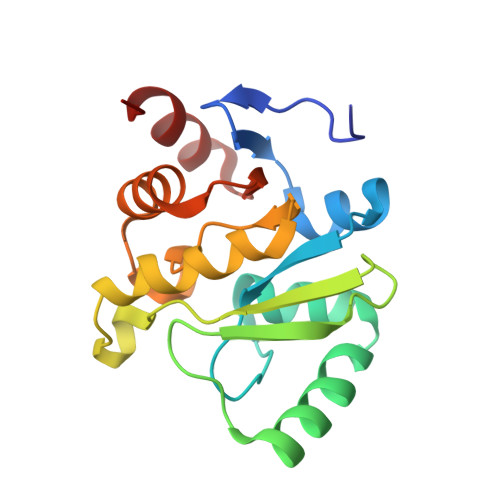Iterative computational design and crystallographic screening identifies potent inhibitors targeting the Nsp3 macrodomain of SARS-CoV-2.
Gahbauer, S., Correy, G.J., Schuller, M., Ferla, M.P., Doruk, Y.U., Rachman, M., Wu, T., Diolaiti, M., Wang, S., Neitz, R.J., Fearon, D., Radchenko, D.S., Moroz, Y.S., Irwin, J.J., Renslo, A.R., Taylor, J.C., Gestwicki, J.E., von Delft, F., Ashworth, A., Ahel, I., Shoichet, B.K., Fraser, J.S.(2023) Proc Natl Acad Sci U S A 120: e2212931120-e2212931120
- PubMed: 36598939
- DOI: https://doi.org/10.1073/pnas.2212931120
- Primary Citation of Related Structures:
5SOI, 5SOJ, 5SOK, 5SOL, 5SOM, 5SON, 5SOO, 5SOP, 5SOQ, 5SOR, 5SOS, 5SOT, 5SOU, 5SOV, 5SOW, 5SOX, 5SOY, 5SOZ, 5SP0, 5SP1, 5SP2, 5SP3, 5SP4, 5SP6, 5SP7, 5SP8, 5SP9, 5SPA, 5SPB, 5SPC, 5SPD, 5SPE, 5SPF, 5SPG, 5SPH, 5SPI, 5SPJ, 5SPK, 5SPL, 5SPM, 5SPN, 5SPO, 5SPP, 5SPQ, 5SPR, 5SPS, 5SPT, 5SPU, 5SPV, 5SPW - PubMed Abstract:
The nonstructural protein 3 (NSP3) of the severe acute respiratory syndrome-coronavirus-2 (SARS-CoV-2) contains a conserved macrodomain enzyme (Mac1) that is critical for pathogenesis and lethality. While small-molecule inhibitors of Mac1 have great therapeutic potential, at the outset of the COVID-19 pandemic, there were no well-validated inhibitors for this protein nor, indeed, the macrodomain enzyme family, making this target a pharmacological orphan. Here, we report the structure-based discovery and development of several different chemical scaffolds exhibiting low- to sub-micromolar affinity for Mac1 through iterations of computer-aided design, structural characterization by ultra-high-resolution protein crystallography, and binding evaluation. Potent scaffolds were designed with in silico fragment linkage and by ultra-large library docking of over 450 million molecules. Both techniques leverage the computational exploration of tangible chemical space and are applicable to other pharmacological orphans. Overall, 160 ligands in 119 different scaffolds were discovered, and 153 Mac1-ligand complex crystal structures were determined, typically to 1 Å resolution or better. Our analyses discovered selective and cell-permeable molecules, unexpected ligand-mediated conformational changes within the active site, and key inhibitor motifs that will template future drug development against Mac1.
Organizational Affiliation:
Department of Pharmaceutical Chemistry, University of California San Francisco, San Francisco, CA 94158.















